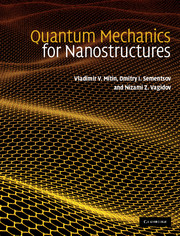Book contents
- Frontmatter
- Contents
- Preface
- List of notation
- 1 The nanoworld and quantum physics
- 2 Wave–particle duality and its manifestation in radiation and particle behavior
- 3 Layered nanostructures as the simplest systems to study electron behavior in a one-dimensional potential
- 4 Additional examples of quantized motion
- 5 Approximate methods of finding quantum states
- 6 Quantum states in atoms and molecules
- 7 Quantization in nanostructures
- 8 Nanostructures and their applications
- Appendix A Classical dynamics of particles and waves
- Appendix B Electromagnetic fields and waves
- Appendix C Crystals as atomic lattices
- Appendix D Tables of units
- Index
6 - Quantum states in atoms and molecules
Published online by Cambridge University Press: 05 June 2012
- Frontmatter
- Contents
- Preface
- List of notation
- 1 The nanoworld and quantum physics
- 2 Wave–particle duality and its manifestation in radiation and particle behavior
- 3 Layered nanostructures as the simplest systems to study electron behavior in a one-dimensional potential
- 4 Additional examples of quantized motion
- 5 Approximate methods of finding quantum states
- 6 Quantum states in atoms and molecules
- 7 Quantization in nanostructures
- 8 Nanostructures and their applications
- Appendix A Classical dynamics of particles and waves
- Appendix B Electromagnetic fields and waves
- Appendix C Crystals as atomic lattices
- Appendix D Tables of units
- Index
Summary
The main characteristics of atoms and molecules are their structure and their energy spectrum. Under the term structure of an arbitrary particle we usually understand the size and the distribution of its mass and its charge in space. In quantum physics such a distribution is defined by the square of the modulus of the wavefunction of a particle. The particle itself may consist of a system of other particles that are bound by a certain type of coupling. For example, an atom consists of a nucleus and a system of interacting electrons, a molecule consists of a system of interacting atoms, and so on. If we consider an atom, the nucleus of the atom is assumed to be at rest (the so-called adiabatic approximation). This assumption can be made because the nucleus has a much larger mass than that of an electron (a proton's mass is 1836 times larger than the mass of an electron). Then, the square of the modulus of the wavefunction, ∣ψ(r1, r2, …, rn)∣2, for the system of electrons defines the probability density of finding the j th electron at the point rj. Graphically it is very convenient to depict ∣ψ∣2 in the form of an electron cloud, which can be considered as an averaged distribution of matter added to the mass of the nucleus located at the center of an atom.
- Type
- Chapter
- Information
- Quantum Mechanics for Nanostructures , pp. 155 - 192Publisher: Cambridge University PressPrint publication year: 2010



